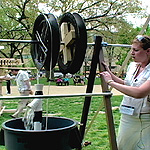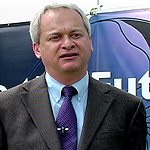2007年VOA标准英语-Students' Designs Provide Look into Future
时间:2019-01-12 作者:英语课 分类:2007年VOA标准英语(四月)
Washington, D.C.
26 April 2007
At the base of the U.S. Capitol in Washington D.C., 41 teams of college students are competing in the National Sustainable Design Expo. Some of their environmentally friendly and sustainable projects could turn out to be the wave of the future. Producer Zulima Palacio checked out some of the projects and prepared this report. Jim Bertel narrates 1 the story.
From a "Mechanical Aerator 2" that oxygenates shrimp 3 hatcheries and keeps more shrimp alive, to the use of algae 4 for the production of biodiesel, these are just two examples of the college students' creativity to solve problems.
"This is our camel wheel,” explains Kim Morris from the University of New Hampshire, “so the camel walks in circles -- he's going to be our camel -- so as the camel walks in circles, it pumps water out of the well, using the rope-and-washer pump design."

Kim Morris explains her team's low technology water pump prototype
Morris and her team of students from the University of New Hampshire developed a sustainable low-technology rope-and-washer system to irrigate 5 school community gardens in Nigeria.
"This is a system set up in Africa. It is set up to kind of funnel 6 the water that you see coming out of this pipe directly into the cistern 7," she says.
And from the cistern the water goes into an irrigation system already in place in Nigeria, where the real project is installed.
The 41 teams of students are trying to win one of the six $75,000 awards for the commercial development of their projects. The U.S. Environmental Protection Agency (EPA) is helping 8 to sponsor the competition. Chris Zarba is the deputy director for the National Center for Environmental research within the EPA.

Chris Zarba, Environmental Protection Agency
"We look into the future and it is in this building right here, where young people are coming up with new ideas and bringing it to the public that really needs it," he says.
"Right now I am producing about three amps,” says Michael Eggleston, “which then goes to a 12 volt 9 DC battery -- that is about 36 watts 10 and that's enough to power about two of these [laptop computers]."
At the "Calories to Kilowatts 11" project Eggleston and his team from Albion College in the Midwest state of Michigan plan to create an energy education workout center in Cambodia, where students can convert human energy into electricity. Once they have enough energy stored they can use it in their living spaces and to study at night.
And for this team of student engineers from Rochester Institute of Technology in New York State, the issue is clean water. Nathan LaCroix explains their solar pasteurizer for treating water in rural areas.
"The whole idea is we dump water on the top bucket in the morning and throughout the day, the sun will heat the pasteurizer, it will heat it up and empty it into the lower bucket."
The water pasteurizer was initially 12 designed for Venezuela. But now team members say it can work almost anywhere, producing more than 20 liters of clean water a day with these buckets.
The National Sustainable Design Expo plans to open its doors to international students within the next two or three years. But for the American college students who participated in this year's expo, they are already in the forefront of cutting-edge technologies for a sustainable future.
- It narrates the unconstitutional acts of James II. 它历数了詹姆斯二世的违法行为。 来自辞典例句
- Chapter three narrates the economy activity which Jew return the Occident. 第三章讲述了犹太人重返西欧后的经济活动。 来自互联网
- An expert system with multiple objectives programming for aerator selection was established. 介绍一个曝气装置选用多目标专家系统。 来自互联网
- Jet aerator especially self-suction jet aerator can meet the need well. 射流曝气,尤其是自吸式射流曝气就可较好地满足这一要求。 来自互联网
- When the shrimp farm is built it will block the stream.一旦养虾场建起来,将会截断这条河流。
- When it comes to seafood,I like shrimp the best.说到海鲜,我最喜欢虾。
- Most algae live in water.多数藻类生长在水中。
- Algae grow and spread quickly in the lake.湖中水藻滋蔓。
- The farmer dug several trenches to irrigate the rice fields.这个农民挖了好几条沟以灌溉稻田。
- They have built canals to irrigate the desert.他们建造成水渠以灌溉沙漠。
- He poured the petrol into the car through a funnel.他用一个漏斗把汽油灌入汽车。
- I like the ship with a yellow funnel.我喜欢那条有黄烟囱的船。
- The cistern is empty but soon fills again.蓄水池里现在没水,但不久就会储满水的。
- The lavatory cistern overflowed.厕所水箱的水溢出来了
- The poor children regularly pony up for a second helping of my hamburger. 那些可怜的孩子们总是要求我把我的汉堡包再给他们一份。
- By doing this, they may at times be helping to restore competition. 这样一来, 他在某些时候,有助于竞争的加强。
- You may use 100 and 110 volt appliances in your room.您可以在房间使用100及110伏特的电器。
- The common service voltage of electric power in our country is 220/380 volt.我国普通供电电压为220/380伏。
- My lamp uses 60 watts; my toaster uses 600 watts. 我的灯用60瓦,我的烤面包器用600瓦。
- My lamp uses 40 watts. 我的灯40瓦。
- It's about 500 kilowatts per hour on average. 年用电量平均为每小时500千瓦。 来自商贸英语会话
- We have an emergency-standby electric generator with a capacity of 300 kilowatts. 我们有一台三百千瓦的事故备用发电机。